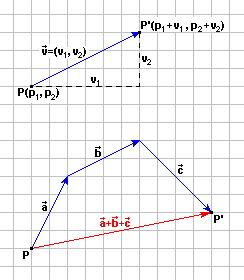|
ACTIVITY 2.7 |
|||
|
Make a translation of a point P according to a vector Observe that if COMPOSITION OF TRANSLATIONS Because the vector sum is commutative, the composition of translations also will be commutative. |
 |
|
INTERACTIVE ACTIVITY This construction represents the three vector sum 1) Three given translations by 2) Three given translations by 3) Three given translations by 4) Three given translations by |
|
| HOMEWORK |
You make in your work notebook the following compositions of three translation applied to any point:
a) Three given translations by![]() = (5,7),
= (5,7), ![]() = (6,-5) and
= (6,-5) and![]() = (-11, -2.)
= (-11, -2.)
b) Given by![]() = (-5, -2),
= (-5, -2), ![]() = (10,0) and
= (10,0) and![]() = (0,10.)
= (0,10.)
c) Given by![]() = (9,9),
= (9,9), ![]() = (0,-9) and
= (0,-9) and![]() = (-12,8.)
= (-12,8.)
|
END OF ACTIVITY 2.7 |
|||